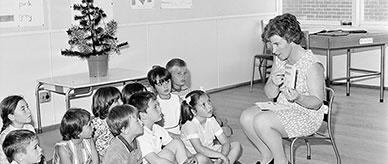
Transcript
Girl: Gran, what did I say?
Grandmother: Ah, you said: 'We’ll start using dollars and cents all over Australia on February 14th 1966. One dollar equals exactly ten shillings. Two dollars equal exactly one pound'.
Girl: What else? Get with it!
[MUSIC BEGINS]
Grandmother: I know! For about two years after February 14th 1966 we use both kinds of money: dollars and cents, pounds, shillings and pence. All shopping can be done with both kinds of money. So dollars and cents are as good as pounds, shillings and pence. During the two years after February 14 pounds, shillings and pence gradually will go out of circulation, then we’ll use dollars and cents. Two kinds of money for about two years – dollars and cents, pounds, shillings and pence – one as good as the other. The old money gradually making way for the new.
[MUSIC ENDS]
Girl: Right!
Grandmother: See, even a little old lady like me can get with it.
[END]
About this record
This is an animated black-and-white television advertisement designed to assist Australians with the transition from imperial to decimal currency on 14 February 1966. Through a question-and-answer format, a grandmother and a small girl explain the transition between currencies, the comparative value of each currency and the ability to use either dollars and cents or pounds, shillings and pence for up to two years after the new currency goes into circulation.
Educational value
- This advertisement was part of a nationwide public education program to inform and prepare Australians for both the introduction of the new currency system on 14 February 1966 and the phasing out of imperial currency over the following two years. In 1958 Prime Minister Robert Menzies (1894–1978) had made an election promise to convert to a new currency system. His treasurer and later successor, Harold Holt, oversaw the introduction.
- In 1960 Treasurer Holt announced the appointment of the Decimal Currency Committee (later Decimal Currency Board) to advise on currency reform. The introduction of decimal currency was significant in the development of Australia’s postwar national identity and economic independence. The monarchist Menzies and his government had initially proposed the name ‘royal’ for the new currency unit, but public outcry saw the new unit named the dollar.
- The system of decimal notes and coins replaced the previous system based on British pounds, shillings and pence. In the old system 12 pence were equal to 1 shilling, and 20 shillings were equal to £1. In the decimal system 100 cents equals $1. At the time of introduction, $1 equalled 10 shillings. Six denominations of decimal coins were issued: 1 cent, 2 cent, 5 cent, 10 cent, 20 cent and 50 cent, and four banknote denominations: $1, $2, $10 and $20.
- The emphasis in the clip on sustained monetary value and on a dual currency system during the transition was intended to reassure the public and alleviate concerns about the changeover period. The advertisement is designed to present the transition as a smooth process and to explain the comparable monetary values of the imperial and decimal currency systems in a way that is easy to understand.
- The clip uses animation as a stylistic and narrative technique to present its message in an entertaining and simple way. It was one of a series of animated and moving footage advertisements produced for the Decimal Currency Board between 1963 and 1966. Central to the publicity campaign was the cartoon character ‘Dollar Bill’ and a jingle sung to the tune of Click Go the Shears. Educational material such as games and play money was distributed to schools.
Acknowledgments
Learning resource text © Education Services Australia Limited and the National Archives of Australia 2010.
Need help with your research?
Learn how to interpret primary sources, use our collection and more.

